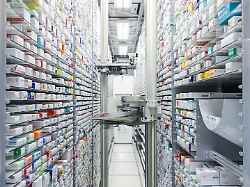Rapidly increasing costs for active ingredients and production make the manufacture of medicines such as fever syrups a loss-making business. With dramatic consequences – not only for domestic companies.
While there are increasing signals in some sectors that the supply chains are easing, the bottlenecks in pharmacies will only really hit the spot this winter: fever syrups for children, cough medicine and breast cancer medication are in short supply.
According to a survey by the Federal Association of Drug Manufacturers, 18 percent of people in the country either didn’t get their drug at all or only got it after a long wait. A possible explanation for this: pharmacies and wholesalers have overstocked their warehouses, which is why there are no medicines elsewhere. It is therefore not a supply problem, but a distribution problem.
Pharmacies and trade unions, on the other hand, see globalization as the cause. According to a study by the pharmaceutical association vfa, around 68 percent of the production sites for active ingredients intended for Europe are in Asia, which is less expensive. While Germany used to be the pharmacy of the world, today it is China and India. If there are manufacturing problems, contamination or a production standstill, this also affects Germany.
Globalization not solely to blame
But according to Jasmina Kirchhoff from the German Economic Institute (IW), it’s not that simple. In her opinion, the economic pressure in Germany itself also plays a decisive role in the current shortage of medicines. “Not all delivery bottlenecks that we are currently observing are due to problems with supply chains or production difficulties,” she says in an interview with ntv.de.
The production of generics, i.e. imitation products of medicines with the same active ingredient, is hardly worthwhile for many companies in Germany with significantly increased costs for energy and transport. “Since the prices for medicines are regulated, manufacturers cannot simply pass the costs on to their customers,” says Kirchhoff.
In the case of prescription drugs, manufacturers must grant discounts to health insurance companies in discount agreements. In addition, there are fixed maximum amounts that the statutory health insurers pay for a drug. This should help to limit costs in the healthcare system and curb the increase in health insurance contributions.
The price determines who gets the bid
“Rapidly increasing drug and production costs with frozen prices make the production of medicines such as fever syrups a loss-making business,” agrees Bork Bretthauer, Managing Director of the Pro Generika Association. Fever juices for children do not require a prescription. The costs for this are reimbursed by the cash registers with fixed amounts to companies.
According to Pro Generika, the producers of paracetamol fever juices receive 1.36 euros per bottle. However, the active ingredient had become 70 percent more expensive within a year. More and more manufacturers are therefore withdrawing from production. In the meantime, only one main provider is left. And this is where it becomes problematic, according to Kirchhoff: “If the number of manufacturers decreases successively, dependency increases and supply chains become more vulnerable.”
The IW expert agrees with the general demand for more active ingredient production in Europe, but points out that relocating the production sites is time-consuming and expensive. “The cost of setting up or expanding a production facility can run into the billions, and it can easily take five years from the start of construction work to acceptance by the authorities.”
Companies in Germany are currently winning tenders that offer the lowest price. “In order to prevent drug supply bottlenecks, manufacturers must be rewarded in the future if they invest in robust supply chains, contract with a second or third supplier, or offer another production site,” says Kirchhoff. This initially increases the price, but also the security of supply.
Federal institute is practicing damage limitation
The Federal Institute for Drugs and Medical Devices (BfArM) currently lists around 300 reports of supply bottlenecks – with around 100,000 approved drugs in Germany. “There have been bottlenecks in the supply of medicines for years. However, the situation seems particularly tense at the moment. It is difficult to estimate when an easing can be expected. But one thing is clear, in order to solve the structural problem, we have to get away from the main thing cheap mentality,” says Kirchhoff.
Meanwhile, the BfArM is practicing damage limitation and points out that there are alternatives for many medicines. “A delivery bottleneck does not therefore have to be a supply bottleneck at the same time,” it says. There are currently only around 10 reports on active ingredients that are critical to supply. The authority therefore sees “no indications of a general acute deterioration in the supply situation in Germany”.
To ensure that a supply bottleneck does not become a supply bottleneck, some are calling for a stock of certain medicines to be set up. “A so-called national reserve can certainly help as a buffer in certain shock situations,” says Kirchhoff. For them, however, it is much more important that politicians recognize that the price cannot be the sole factor that decides where health insurance companies buy their medicines.
